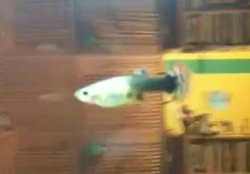Welcome to the forum Nastenka.
Your female guppy does not look very close to a drop to me. From your fuzzy picture I would guess she has at least 2 weeks to go. There is a link in my signature to a thread that I called Ready to Drop that links to a thread by 5teady that has lots of pictures of various stages of a livebearer's pregnancy.
A much more urgent question that you may have is about cycling a tank. A tank cycle is done, with fish in, by changing water every time that the water chemistry starts to show signs of having any ammonia or nitrites present. Nitrates are far less harmful so we often ignore them during a cycle. In order to have success doing a fish-in cycle, you will newed a decent liquid reagent type test kit, the kind with the little test tubes in it. Many of us here use the API freshwater master test kit since it includes everything we really need to be successful. When you use a good kit top measure the ammonia and nitrites you basically need to keep your ammonia and nitrite levels below about 0.25 ppm by doing water changes and wait until you no longer need to do them to keep the chemical contaminants under control. At that point, your filter will have developed enough of a bacteria colony in it to process all of the ammonia being produced by your fish.
The nitrogen cycle in a freshwater tank starts with ammonia being produced by the fish in respiration, urination and the decay of their waste products. Ammonia is converted to nitrites by beneficial bacteria but nitrites are also poisonous to fish. Fortunately there are also bacteria that use nitrites to produce nitrates. The nitrates are fairly safe for fish in rather high concentrations, they often are fine as high as 100 ppm. By growing the right bacteria in your filter, we end up with ammonia and nitrites being processed into much less harmful nitrates. The bacteria grow on almost any surface that gets good water flow of oxygenated water that has any trace of ammonia or nitrites in it. When we have these bacterial colonies established, we say the tank or filter is cycled.
There is a link to the fish-in cycle in my signature area. There is also a link to the Beginners Resource Center there. Please read up on the cycling and whatever else of the resource center interests you and come back with any questions you may have. We are here to help you get through this process successfully and will be glad to answer any questions you may have.




